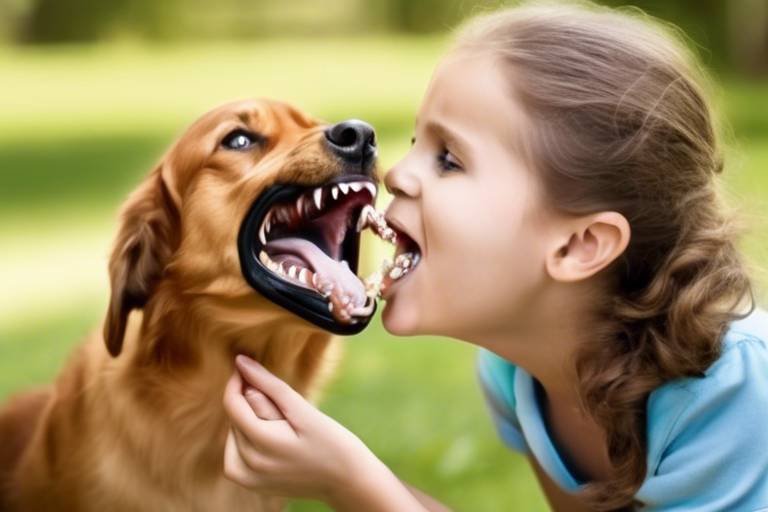Tips for Keeping Your Pet Safe During Winter
Winter is a magical season, filled with snowflakes, cozy nights, and festive cheer. However, it also brings a host of challenges, especially for our furry companions. As pet owners, it’s our responsibility to ensure that our pets are not only comfortable but also safe during these colder months. Imagine your pet, shivering at the door, eager to play but vulnerable to the harsh elements outside. It’s a heart-wrenching thought, isn’t it? But fear not! With a few essential tips and some proactive measures, you can turn winter into a delightful experience for your pets.
First and foremost, understanding the specific hazards that winter presents is crucial. Extreme cold can lead to frostbite and hypothermia in pets, especially those with short fur or minimal body fat. Ice and snow can hide dangerous surfaces, and the salt used to de-ice roads can irritate your pet’s paws. Additionally, the shorter days mean less daylight, which can pose visibility issues during walks. By being aware of these dangers, you can take steps to mitigate risks and keep your furry friends safe.
Next, let’s talk about proper winter gear for pets. Just as we bundle up in warm coats and scarves, our pets also need suitable clothing to brave the cold. Coats and sweaters are essential for keeping your pets warm, but how do you choose the right one? Look for materials that provide insulation without being too bulky, allowing your pet to move comfortably. Additionally, ensure the fit is snug but not restrictive, so your pet can enjoy their winter adventures without feeling constrained.
Speaking of winter gear, don’t forget about those precious paws! Ice and salt can wreak havoc on your dog’s feet, leading to irritation or injury. This is where dog boots come into play. They may seem a bit silly at first, but trust me, they can make a world of difference. When selecting boots, ensure they fit well—too tight can cause discomfort, while too loose can lead to them falling off. Your pet might need some time to get used to wearing them, but once they do, they’ll be ready to tackle the winter wonderland!
Visibility is another crucial aspect to consider during the winter months. With shorter days and overcast skies, it’s essential to keep your pet visible during walks. Reflective gear such as collars, leashes, and even jackets can help ensure that your pet is seen by drivers and other pedestrians. It’s a simple yet effective way to enhance safety during those twilight strolls.
Now, let’s not forget about the fun! Engaging in safe outdoor activities can be a blast for both you and your pet. Whether it’s building a snowman together or going for a brisk walk, there are plenty of ways to enjoy the winter landscape. Just remember to keep an eye on your pet for signs of discomfort or fatigue. If they start to shiver or seem reluctant to continue, it’s time to head back indoors.
When the weather is too harsh for outdoor fun, creating a safe and cozy indoor environment is essential. Make sure your home is warm and inviting, with plenty of soft blankets and comfortable spots for your pet to curl up. Consider using space heaters or heating pads, but always supervise to ensure safety. Your pet deserves a warm retreat from the biting cold, just like you do!
Lastly, let’s talk about nutrition and hydration. Winter can be tough on your pet's body, so it's important to ensure they’re getting the right nutrients. You might need to adjust their diet to accommodate for increased energy needs during colder months. Additionally, make sure they have access to fresh water at all times—frozen water bowls can lead to dehydration, which is a serious concern. Keeping your pet hydrated is just as important in winter as it is in summer!
- How can I tell if my pet is too cold? Look for signs like shivering, whining, or seeking shelter. If your pet seems uncomfortable, it's time to head indoors.
- Are all pets suitable for winter walks? Not all pets are equipped for cold weather. Breeds with thick fur may handle the cold better than those with short hair.
- What should I do if my pet gets salt on their paws? Rinse their paws with warm water to remove any salt and prevent irritation.

Understanding Winter Hazards
This article provides essential tips and insights on how to protect your pets from the harsh winter conditions, ensuring their safety and well-being throughout the season.
Winter can be a magical time of year, with snowy landscapes and festive cheer, but it also brings significant hazards for our furry friends. As temperatures drop, it's crucial to recognize the specific dangers that winter poses to pets. One of the most pressing concerns is the extreme cold itself. Just like us, pets can suffer from hypothermia and frostbite if exposed to frigid temperatures for too long. Dogs and cats with short hair, young animals, and seniors are particularly susceptible to the cold, so it's essential to keep a close eye on them when they venture outdoors.
Another hazard that pet owners should be aware of is the presence of ice and snow on the ground. While your dog might love to romp around in the snow, hidden dangers like sharp ice shards can injure their paws. Plus, the salt and chemicals used to de-ice sidewalks and roads can be toxic if ingested. It’s like a hidden minefield that can lead to serious health issues for your beloved pet. Always check your pet's paws after a walk to ensure they’re free from ice and salt buildup.
Additionally, winter can bring about a range of indoor hazards that are often overlooked. With the use of heating devices and festive decorations, the home environment can become a risky place for pets. For example, pets may be tempted to snuggle up to heating vents or space heaters, which can lead to burns or even fires if they get too close. Similarly, holiday plants like poinsettias and mistletoe can be toxic to pets, so it’s important to keep these out of reach. Understanding these hazards is the first step in ensuring that your pet remains safe and sound throughout the winter months.
In summary, recognizing the dangers of winter—both outside and inside the home—will help you take proactive measures to protect your furry companions. By staying informed and vigilant, you can ensure that your pets enjoy the season without unnecessary risks. Remember, a little awareness goes a long way in keeping our pets safe during this chilly time of year!
Just like humans, pets need appropriate clothing for winter weather. This section discusses the types of winter gear available and how to choose the right items for your furry friends.
Choosing the right coat or sweater can significantly impact your pet's comfort in cold weather. This section offers tips on selecting the best fit and material for your pet's needs.
Protecting your pet's paws from ice and salt is essential. This section covers the benefits of dog boots and how to ensure a proper fit for maximum protection.
Winter days often bring reduced visibility. This section emphasizes the importance of reflective gear and accessories to keep your pet visible during walks in low-light conditions.
Engaging in outdoor activities with your pet can be enjoyable, but safety should always come first. This section outlines safe winter activities that you can enjoy together.
When the weather is too harsh for outdoor activities, keeping your pet safe indoors is essential. This section provides tips for creating a secure and comfortable indoor environment.
Ensuring your home is warm and cozy for your pet is vital during winter. This section discusses the best heating practices and cozy spots for your pet to relax.
Proper nutrition and hydration are crucial for your pet's health during winter. This section focuses on dietary adjustments and the importance of keeping water accessible and unfrozen.
Q: How can I tell if my pet is too cold?
A: Look for signs like shivering, whining, or seeking shelter. If your pet seems uncomfortable, it’s time to head indoors.
Q: Can I use human winter clothes for my pets?
A: While some human clothing can work, it's best to use gear specifically designed for pets to ensure a proper fit and comfort.
Q: What should I do if my pet gets salt on their paws?
A: Rinse their paws with warm water and dry them thoroughly to prevent irritation or ingestion of harmful chemicals.

Proper Winter Gear for Pets
As the chilly winds blow and snowflakes begin to dance, it’s time to think about how we can keep our furry friends warm and cozy during the winter months. Just like us, pets can feel the biting cold, and having the right winter gear is essential for their comfort and safety. Whether you have a playful pup or a cuddly kitty, investing in proper winter attire can make all the difference. So, what should you look for when shopping for your pet's winter wardrobe?
First and foremost, consider the climate in your area. If you live in a region where temperatures drop significantly, heavier coats and insulated sweaters are a must. On the other hand, if your winters are milder, lighter jackets may suffice. Always keep in mind your pet’s breed and size; smaller dogs or those with short hair are usually more sensitive to cold. For instance, a Chihuahua might need a thicker coat than a Golden Retriever, who has a natural insulating layer.
When it comes to coats and sweaters, the options are endless! From stylish puffer jackets to snug knit sweaters, you can find something that not only keeps your pet warm but also makes them look adorable. When selecting a coat, look for features like water resistance and breathability. A good coat should keep your pet dry while allowing airflow, so they don’t overheat during playtime. Additionally, ensure that the coat fits snugly but isn’t too tight; you should be able to slide two fingers between the coat and your pet’s body.
Don’t forget about your pet’s paws! Just like we wear boots to protect our feet from the cold and icy surfaces, pets need the same protection. Dog boots are designed to shield their paws from snow, ice, and harmful chemicals like salt used for de-icing roads. When selecting boots, look for durability and grip. The soles should be non-slip to prevent any accidents on slippery surfaces. To ensure a proper fit, measure your pet’s paws carefully and refer to the sizing chart provided by the manufacturer.
Winter days often come with shorter daylight hours, and visibility can be a concern during evening walks. To keep your pet safe, consider investing in reflective gear and accessories. Items like reflective collars, leashes, and even light-up harnesses can make a world of difference. Not only do these accessories enhance your pet’s visibility, but they also provide peace of mind for you as a pet owner. After all, it’s better to be safe than sorry!
In summary, ensuring your pet is equipped with proper winter gear is vital for their safety and comfort. By choosing the right coats, boots, and visibility accessories, you can help your furry friend enjoy the winter wonderland without the worry of cold-related issues. So, bundle up your pets and get ready for some fun in the snow!
Coats and Sweaters
When the temperature drops and winter sets in, your furry friends need more than just love and cuddles; they need the right to keep them warm and comfortable. Just like humans bundle up in cozy attire, your pets also deserve protection from the biting cold. Choosing the right winter gear can make all the difference for your pet's comfort and health during the chilly months. But how do you know what’s best for your four-legged companion?
First and foremost, consider your pet's breed and fur type. Some dogs, like Siberian Huskies and Saint Bernards, have thick fur that naturally insulates them against the cold, while others, such as Chihuahuas and Greyhounds, have less body fat and shorter coats, making them more susceptible to the cold. A well-fitted coat or sweater can help retain body heat and keep your pet cozy during walks or outdoor playtime.
When selecting a coat or sweater, look for materials that provide warmth without sacrificing comfort. Fabrics like fleece and wool are excellent choices, as they offer insulation while allowing your pet to move freely. Additionally, consider the coat's design—options with high collars or harness openings can provide extra warmth and functionality. Here are a few features to keep in mind:
- Water Resistance: A waterproof coat can protect your pet from wet snow and slush.
- Insulation: Look for coats with thick padding or thermal lining.
- Adjustable Straps: Ensure a snug fit to prevent cold air from sneaking in.
It’s also essential to pay attention to the fit of the coat or sweater. A well-fitted garment should allow your pet to move comfortably without being too tight or too loose. Measure your pet’s neck, chest, and back length to find the right size. Many brands provide sizing charts, so be sure to consult these before making a purchase. Remember, a coat that’s too big can be just as ineffective as one that’s too small!
Finally, don't forget about style! Just because your pet needs to stay warm doesn’t mean they can’t look fabulous while doing so. There are countless designs and colors available, from classic plaid to vibrant hues, allowing you to express your pet's personality. After all, who doesn’t love a pet that struts their stuff in a stylish winter coat?
In summary, investing in the right coats and sweaters for your pets can significantly enhance their winter experience. Not only do these garments provide necessary warmth, but they also ensure your furry friends feel secure and comfortable during the colder months. So, as winter approaches, take the time to shop for winter gear that meets your pet’s specific needs, and you'll both enjoy the season much more!
Boots for Paws
When the temperature drops and winter sets in, our furry friends can face some serious challenges, especially when it comes to their paws. Just like we wouldn’t walk barefoot on a freezing sidewalk, our pets need protection too! Dog boots are an essential accessory that can shield your pet's paws from harsh winter elements, including ice, salt, and snow. Imagine your dog happily bounding through the snow without the discomfort of freezing paws—sounds delightful, right?
Choosing the right pair of boots for your pet is crucial. Not all boots are created equal, and finding the perfect fit can make a world of difference. When selecting boots, consider the following factors:
- Size: Measure your dog's paws accurately. Most brands have a sizing chart that can help you pick the right size. Remember, a snug fit is essential, but you don’t want them to be too tight.
- Material: Look for boots made from durable, waterproof materials that can withstand the elements. Rubber soles are great for traction, while insulated fabrics can keep paws warm.
- Design: Some boots come with adjustable straps or closures, ensuring they stay on during your dog’s adventures. A good design can prevent the boots from slipping off, so your pup can run freely without a care.
Once you've chosen the right pair, it's important to get your pet accustomed to wearing them. Start by letting them sniff and explore the boots indoors before trying them out on a walk. Gradually introduce the boots during short outings, rewarding your pet with treats and praise to create a positive association. Remember, patience is key! Some dogs take a little longer to adjust, but soon enough, they’ll be strutting their stuff in style.
Dog boots not only protect against the cold but also guard against harmful chemicals like road salt and antifreeze, which can be toxic to pets. These substances can lead to paw irritation and even serious health issues if ingested. By equipping your dog with boots, you're taking a proactive step to ensure their safety and comfort. So, as you gear up for winter walks, don’t forget to put those boots on your furry friend!
Q: Can all dogs wear boots?
A: While most dogs can wear boots, some may need time to adjust. It's essential to consider your dog's size and breed, as well as their comfort level with wearing footwear.
Q: How do I know if the boots fit properly?
A: The boots should fit snugly but not be too tight. You should be able to slide a finger between the boot and your dog's leg. Make sure they can walk comfortably without any signs of discomfort.
Q: Can my dog wear boots indoors?
A: Yes, especially if your floors are cold or if you have slippery surfaces. Just ensure that your dog is comfortable wearing them inside before heading outdoors.
Q: How do I clean my dog's boots?
A: Most dog boots can be wiped clean with a damp cloth. Check the manufacturer's instructions for specific cleaning guidelines to ensure longevity.
Accessories for Visibility
As winter rolls in, the days get shorter and the nights become longer, making it crucial to ensure your furry friend remains visible during those evening walks. Just imagine walking your dog in the dark; it’s like trying to find a needle in a haystack! To avoid any unfortunate mishaps, investing in reflective gear and accessories can make a world of difference. Not only do these items enhance your pet's visibility, but they also provide an extra layer of safety for both of you.
When selecting visibility accessories, consider options such as reflective collars, leashes, and vests. Reflective collars are a simple yet effective way to ensure your pet stands out against the winter backdrop. Look for collars made from materials that reflect light well, especially if they are brightly colored. A matching reflective leash can amplify this effect, making it easier for you to spot your pet from a distance.
Moreover, reflective vests are an excellent choice, especially for larger dogs or those who love to roam. These vests are designed to fit comfortably and can be easily adjusted to ensure a snug fit. They often come with additional features like pockets for carrying essentials, which is a bonus for those longer winter walks. Just picture your pet prancing around in a bright vest, shining like a beacon in the night!
For smaller pets, consider reflective harnesses. These not only provide visibility but also distribute the pulling force evenly across your pet's body, making walks more comfortable. In addition, adding a light-up collar or a small LED light attached to your pet's harness can further enhance their visibility. These lights are often rechargeable and come in various colors, allowing you to choose one that matches your pet's personality.
Lastly, don't forget about your own visibility! Wearing reflective clothing or accessories can create a safer environment for both you and your pet. After all, you’re a team, and it’s essential to look out for each other. So, gear up and enjoy those winter walks with peace of mind knowing that both you and your furry friend are visible to others!
- What types of reflective gear are best for pets? Look for reflective collars, leashes, vests, and harnesses made from high-visibility materials.
- How can I ensure the gear fits my pet properly? Always measure your pet's neck and chest before purchasing, and opt for adjustable options for a snug fit.
- Are light-up collars safe for pets? Yes, as long as they are made from pet-safe materials and are properly fitted, light-up collars can enhance visibility significantly.
- Can I use human reflective gear for my pet? While it’s not specifically designed for pets, some human gear can be adapted. However, it’s best to use gear made for pets to ensure comfort and safety.
Safe Outdoor Activities
Winter can be a magical time for you and your furry friend, but it’s essential to prioritize safety while enjoying the chilly outdoors. Just imagine the joy of frolicking in the snow, but with the right precautions in place! When the weather permits, there are plenty of that can keep both you and your pet active and entertained. However, before heading out, it's crucial to be mindful of the conditions and your pet's tolerance to cold. Always remember, a little caution goes a long way!
One fantastic way to engage with your pet is by taking them for a winter walk. The key is to choose a route that is safe and free from ice patches. Avoid busy roads where salt and chemicals might be present, as they can irritate your pet's paws. Instead, opt for a quiet park or a nature trail. Just think of it as a winter wonderland adventure! To make it even more enjoyable, you can bring along a friend or family member to join in the fun. Not only does this add to the experience, but it also provides an extra set of eyes to ensure everyone's safety.
If your pet enjoys playing fetch, you can modify this classic game for the winter. Use a bright, colorful ball that stands out against the white snow, making it easier for your pet to spot. Just be sure to limit the duration of playtime, as cold weather can be exhausting for pets. After a good session of fetch, a warm treat is a perfect way to reward your furry companion! And speaking of treats, consider bringing along some snacks and water to keep your pet hydrated and energized during your outdoor excursions.
Another enjoyable activity is building a snow fort or a snowman together! This can be a fun way for your pet to interact with the snow, and you can even hide treats within the fort for a delightful treasure hunt. Just keep an eye on your pet to ensure they don’t eat too much snow, as it can lead to tummy troubles. Remember, moderation is key!
For pets that love to run, consider a safe area where they can play off-leash. Always check for any potential hazards in the area, such as broken glass or sharp objects hidden beneath the snow. If you’re unsure about an area, it’s better to err on the side of caution. A fenced-in dog park can also be a great option, providing a controlled environment for your pet to socialize and burn off some energy.
Finally, remember to keep an eye on your pet for any signs of discomfort. If they start shivering, lifting their paws off the ground, or seem hesitant to continue, it’s time to head back inside. After all, just like us, pets can get cold too! Keeping a watchful eye on their behavior will help ensure that your winter adventures remain safe and enjoyable.
Q: How long can I walk my dog in the winter?
A: It depends on your dog's breed, size, and tolerance to cold. Generally, shorter walks are better during extreme cold, while active breeds may enjoy longer outings. Always monitor your pet for signs of discomfort.
Q: Is it safe for my pet to play in the snow?
A: Yes, as long as you supervise them and ensure that the snow is clean and free from harmful substances. Avoid letting them eat large amounts of snow, as it can lead to digestive issues.
Q: What should I do if my pet gets cold?
A: If your pet shows signs of being cold, such as shivering or reluctance to move, bring them inside immediately and warm them up with a blanket. Consult your vet if you have concerns about hypothermia.

Indoor Safety Tips
When winter's chill sets in, it can be tempting to hibernate indoors with your furry companions. However, keeping your pets safe and comfortable inside is just as important as outdoor precautions. First and foremost, ensure that your home is a warm and cozy haven for your pets. Heating plays a crucial role in their comfort. Make sure to check your heating systems regularly to avoid any unexpected breakdowns during the coldest months. Consider using space heaters in specific areas where your pets like to relax, but always supervise them to prevent any accidents.
Creating the perfect cozy spot for your pet to curl up is essential. Think about setting up a warm bed in a draft-free area, perhaps near a radiator or in a sunlit corner. Blankets, pillows, and even pet-specific heated beds can make a world of difference. Just like us, pets appreciate a snug space where they can feel safe and secure. Don’t forget to check on them regularly to ensure they’re not too hot or too cold!
Nutrition and hydration are also vital during the winter months. As the temperature drops, your pet may require a slight adjustment in their diet. High-quality food can help maintain their energy levels, especially if they’re more active indoors. Additionally, make sure their water supply is always accessible and unfrozen. During winter, pets can become dehydrated just as easily as in summer, so it’s essential to monitor their water bowls. Consider using heated water bowls to keep the water from freezing.
Lastly, it’s important to keep your indoor environment safe. With the holiday season approaching, be cautious about decorations and plants that may be harmful to pets. For instance, many common holiday plants, such as poinsettias and mistletoe, can be toxic. Always double-check that any plants you bring into your home are pet-friendly. Also, be mindful of small decorations that can pose choking hazards or items that can be easily knocked over by curious paws.
In summary, ensuring your home is a safe and comfortable environment for your pets during winter involves a combination of maintaining warmth, providing proper nutrition, and being vigilant about potential hazards. With a little effort, you can create a winter wonderland that keeps your furry friends happy and healthy!
Q: How can I tell if my pet is too cold?
A: Signs that your pet may be too cold include shivering, whining, or seeking shelter. If they seem reluctant to go outside, it’s a good indicator that the weather is too harsh for them.
Q: Can I use human blankets for my pet?
A: Yes, human blankets can be used, but ensure they are clean and free from any harmful materials. You may also want to invest in pet-specific blankets for added comfort.
Q: What should I do if my pet refuses to drink water?
A: If your pet is not drinking enough water, try offering them fresh water frequently or consider adding some low-sodium broth to entice them. Always ensure their water bowl is clean and unfrozen.
Q: Are there any indoor activities to keep my pet entertained during winter?
A: Absolutely! Engage your pets with indoor games like hide and seek, puzzle toys, or even training sessions to keep their minds sharp and bodies active.
Heating and Comfort
When winter rolls in, the chill can seep into every corner of your home, making it essential to create a warm and cozy environment for your furry friends. Just like you, your pets need a comfortable space to hibernate during those frigid months. So, how can you ensure that your home is a snug haven for them? First off, consider the heating sources you have in place. Central heating is a great start, but it’s important to monitor the temperature and make sure it stays at a comfortable level for your pets. Ideally, you want to maintain a temperature between 68°F and 72°F (20°C to 22°C) to keep them cozy.
Additionally, think about where your pet spends most of their time. Is it on a cold tile floor or near a drafty window? If so, it might be time to invest in some pet-friendly heating solutions. Heated pet beds or blankets can be a game-changer, providing your pets with a warm spot to curl up and relax. These beds come in various sizes and materials, so you can easily find one that suits your pet's needs. Just be sure to supervise your pet when using heated products to avoid any accidents.
Another great way to keep your pets warm is by creating a designated cozy corner in your home. This can be a simple setup with soft blankets, pillows, and maybe even a few of their favorite toys. You can also use pet-safe heating pads to add an extra layer of warmth. Just like you might snuggle under a blanket with a good book, your pets will appreciate having their own little sanctuary to retreat to when the temperature drops.
Don't forget about the importance of proper insulation in your home. Drafts can make even the warmest rooms feel chilly. Check your windows and doors for any gaps and seal them up to keep the heat in. You can even use thermal curtains to help retain warmth. This not only benefits your pets but also makes your home more energy-efficient!
Lastly, remember that hydration is equally important for your pets during winter. While it may be cold, pets can still become dehydrated, especially if they spend time near heating sources. Make sure their water bowls are filled with fresh, unfrozen water at all times. If you notice their water is freezing, consider using a heated water bowl to keep it at a drinkable temperature.
In summary, keeping your pets warm and comfortable during winter is all about creating a safe and cozy environment. From proper heating practices to cozy corners and hydration, a little attention goes a long way in ensuring your pets stay happy and healthy throughout the cold season. After all, a warm pet is a happy pet!
- What temperature is too cold for pets? Generally, if the temperature drops below 32°F (0°C), it’s best to keep your pets indoors, especially smaller breeds and those with short coats.
- Can pets get cold indoors? Yes, pets can feel cold indoors, particularly if they are on cold surfaces or if there are drafts. Providing them with warm bedding and blankets can help.
- How can I keep my pet's water from freezing? Consider using heated water bowls or placing their water bowl in a warmer area of your home.
Nutrition and Hydration
When winter rolls in, it’s not just the cold we need to worry about; our pets require some extra attention to their nutrition and hydration as well. Just like we tend to crave hearty meals to keep warm, our furry friends may need adjustments to their diets during the colder months. The cold can increase their metabolism, meaning they might need more calories to maintain their energy levels. It's essential to keep an eye on their food intake and ensure they are getting the right nutrients to stay healthy and active.
One of the key aspects of winter pet care is ensuring that your pet stays hydrated. It’s easy to overlook hydration when temperatures drop, but dehydration can still be a risk. Water bowls can freeze, so it’s crucial to check them regularly and provide fresh, unfrozen water. You might even consider using a heated water bowl to keep your pet's drinking water at a comfortable temperature. Additionally, incorporating wet food into your pet’s diet can help increase their moisture intake, which is particularly beneficial during the dry winter months.
Moreover, consider adjusting your pet's diet based on their activity levels. If you're spending more time indoors and your pet is less active, you might want to reduce their portion sizes to prevent weight gain. Conversely, if you’re engaging in outdoor activities, they may require more food to fuel their adventures. Consulting with your veterinarian can help you make the best dietary choices tailored to your pet’s specific needs.
Here’s a quick breakdown of some winter nutrition tips:
- Increase Calories: Consider providing more calories if your pet is active outdoors.
- Hydration is Key: Always ensure your pet has access to fresh water, and consider a heated bowl.
- Consider Wet Food: Adding wet food can help maintain hydration levels.
- Monitor Weight: Adjust portions based on activity levels to prevent weight gain.
In summary, keeping your pet well-nourished and hydrated during winter is not just about preventing discomfort; it’s about ensuring their overall health and happiness. By paying attention to their dietary needs and hydration levels, you can help your furry friend thrive even in the coldest months.
Q: How can I tell if my pet is dehydrated?
A: Signs of dehydration in pets include dry gums, lethargy, and loss of appetite. You can also perform a skin tent test by gently pulling up the skin on the back of their neck; if it doesn't spring back quickly, they may be dehydrated.
Q: Should I change my pet's diet in winter?
A: Yes, you may need to adjust their diet based on their activity levels. If they are more active, they may require more calories, while less active pets might need fewer calories to maintain a healthy weight.
Q: Is it safe to give my pet warm food in winter?
A: Yes, warm food can be comforting for pets in winter, but make sure it’s not too hot. Always check the temperature before serving.
Q: How often should I check my pet's water bowl in winter?
A: It’s best to check their water bowl several times a day to ensure it hasn’t frozen and that they have access to fresh water at all times.
Frequently Asked Questions
- What are the main winter hazards for pets?
Winter can be tough on our furry friends! The main hazards include extreme cold temperatures, ice, snow, and even harmful chemicals like antifreeze. Keeping an eye on your pet during these conditions is essential to ensure their safety and well-being.
- Do pets need special winter clothing?
Absolutely! Just like us, pets can get chilly in cold weather. Depending on their breed and coat type, they may need coats, sweaters, and even boots to keep them warm and protected from the harsh elements.
- How do I choose the right winter gear for my pet?
When selecting winter gear, consider the size, fit, and material. Look for items that provide warmth without restricting movement. Also, make sure that the gear is easy to put on and take off, as pets can be a bit fidgety!
- Are dog boots necessary?
Yes, dog boots can be a lifesaver! They protect your pet's paws from ice, snow, and harmful chemicals like salt. Just ensure they fit properly to avoid discomfort while walking.
- How can I keep my pet safe during outdoor activities in winter?
Always supervise your pet during outdoor playtime. Stick to safe activities that don’t expose them to extreme cold for too long. Also, consider shorter walks and play sessions, especially during frigid temperatures.
- What indoor safety tips should I follow for my pet during winter?
Make sure your home is warm and cozy for your pet. Create a comfortable resting area away from drafts, and keep their bedding clean and dry. Also, ensure they have access to fresh, unfrozen water at all times!
- How can I adjust my pet's diet during winter?
During winter, pets may need a bit more food to maintain their energy levels, especially if they are more active outdoors. Consult your vet for tailored advice on dietary adjustments to keep your pet healthy and happy!
- What should I do if my pet gets cold outside?
If you notice your pet shivering or showing signs of discomfort, bring them inside immediately. Warm them up gradually with a cozy blanket and check for any signs of frostbite or hypothermia. If in doubt, consult your veterinarian.



















